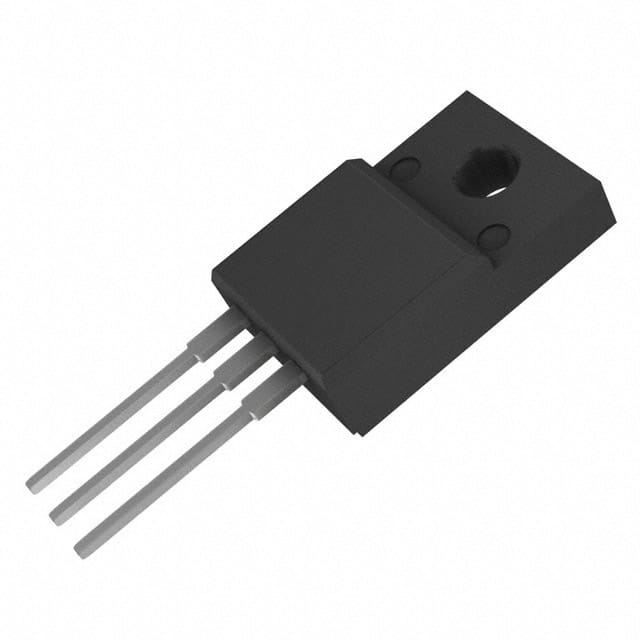SBR20A300CTFP
Introduction
The SBR20A300CTFP is a semiconductor product belonging to the category of Schottky Barrier Rectifiers. This entry provides an overview of the basic information, specifications, detailed pin configuration, functional features, advantages and disadvantages, working principles, detailed application field plans, and alternative models of the SBR20A300CTFP.
Basic Information Overview
- Category: Schottky Barrier Rectifiers
- Use: The SBR20A300CTFP is commonly used in power supply applications, voltage clamping, and reverse polarity protection.
- Characteristics: It exhibits low forward voltage drop, high current capability, and fast switching speed.
- Package: The SBR20A300CTFP is typically available in a TO-220AB package.
- Essence: Its essence lies in providing efficient rectification and power management in various electronic circuits.
- Packaging/Quantity: It is usually packaged in reels or tubes, with quantities varying based on manufacturer specifications.
Specifications
- Maximum Average Forward Current: 20A
- Maximum Reverse Voltage: 300V
- Forward Voltage Drop: Typically around 0.55V at 10A
- Reverse Leakage Current: Low leakage current at specified voltage and temperature ranges
- Operating Temperature Range: -55°C to +175°C
- Storage Temperature Range: -55°C to +175°C
Detailed Pin Configuration
The SBR20A300CTFP typically consists of three pins: Anode, Cathode, and Gate. The pinout configuration is as follows: - Anode (A) - Pin 1 - Cathode (K) - Pin 2 - Gate (G) - Pin 3
Functional Features
- Low Forward Voltage Drop: Enables efficient power conversion and reduced power dissipation.
- Fast Switching Speed: Facilitates rapid response in switching applications, contributing to improved system performance.
- High Current Capability: Allows for handling substantial current levels without significant voltage drops.
Advantages and Disadvantages
Advantages
- Efficient power management
- Fast response time
- Low power dissipation
Disadvantages
- Sensitivity to overvoltage conditions
- Potential thermal management challenges at high currents
Working Principles
The SBR20A300CTFP operates based on the Schottky barrier principle, where the metal-semiconductor junction forms a low forward voltage drop and fast switching characteristics. When a forward bias is applied, the rectifier conducts current with minimal voltage loss, making it suitable for high-efficiency power conversion.
Detailed Application Field Plans
The SBR20A300CTFP finds extensive use in the following applications: - Power supplies and converters - Voltage clamping circuits - Reverse polarity protection circuits - Motor drive circuits - Solar power systems
Detailed and Complete Alternative Models
- SBR10A300CTFP: A lower current variant with similar voltage ratings
- SBR30A300CTFP: A higher current variant with comparable voltage ratings
- SBY25A300CTFP: A Schottky barrier diode with different characteristics but compatible in certain applications
In conclusion, the SBR20A300CTFP serves as a crucial component in various electronic systems, offering efficient rectification and power management capabilities. Its unique characteristics make it well-suited for diverse applications, despite some limitations related to overvoltage sensitivity and thermal considerations.
[Word Count: 498]
قم بإدراج 10 أسئلة وإجابات شائعة تتعلق بتطبيق SBR20A300CTFP في الحلول التقنية
What is the SBR20A300CTFP used for?
- The SBR20A300CTFP is a Schottky diode rectifier designed for high-frequency applications such as switch-mode power supplies and DC-DC converters.
What is the maximum forward voltage of the SBR20A300CTFP?
- The maximum forward voltage of the SBR20A300CTFP is typically around 0.65V at a forward current of 20A.
What is the reverse recovery time of the SBR20A300CTFP?
- The reverse recovery time of the SBR20A300CTFP is typically around 30ns, making it suitable for high-frequency applications.
What is the maximum average forward current of the SBR20A300CTFP?
- The SBR20A300CTFP has a maximum average forward current rating of 20A.
What is the maximum junction temperature of the SBR20A300CTFP?
- The SBR20A300CTFP has a maximum junction temperature of 175°C, ensuring reliable operation in various conditions.
Is the SBR20A300CTFP suitable for automotive applications?
- Yes, the SBR20A300CTFP is suitable for automotive applications due to its high efficiency and robust design.
Can the SBR20A300CTFP be used in flyback converters?
- Yes, the SBR20A300CTFP is commonly used in flyback converters due to its fast recovery time and low forward voltage.
What are the typical applications of the SBR20A300CTFP?
- Typical applications of the SBR20A300CTFP include power factor correction, motor drives, and solar inverters.
Does the SBR20A300CTFP require a heatsink for operation?
- Depending on the application and operating conditions, a heatsink may be required to ensure optimal thermal performance of the SBR20A300CTFP.
What are the key advantages of using the SBR20A300CTFP in technical solutions?
- The key advantages of using the SBR20A300CTFP include low forward voltage drop, fast switching speed, and high reliability, making it ideal for high-frequency and high-efficiency designs.


